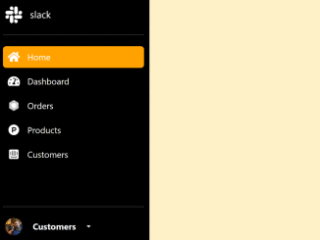Here’s a comprehensive tutorial on how to create a dynamic Sidebar Menu Hover Show/hide Bootstrap 5 effect. This guide will walk you through the necessary HTML structure and CSS styling to achieve a sleek and interactive sidebar.
Step 1: Include Header Assets
First, you’ll need to include the necessary CSS stylesheets in the “ section of your HTML document. This includes Bootstrap for styling and Font Awesome for icons.
<link rel='stylesheet' href='https://cdn.jsdelivr.net/npm/bootstrap@5.2.3/dist/css/bootstrap.min.css'> <link rel='stylesheet' href='https://cdnjs.cloudflare.com/ajax/libs/font-awesome/5.15.4/css/all.min.css'>
Step 2: Create the HTML Structure
Next, build the HTML structure for your sidebar menu. This involves creating a container for the sidebar and adding the necessary navigation links and a dropdown for user settings.
<body>
<header>
<div class="d-flex flex-column flex-shrink-0 sidebar-wrap">
<a href="/" class="text-decoration-none logo-wrap">
<div class="icon-wrap"><i class="fab fa-slack"></i></div> <span>slack</span>
</a>
<hr>
<ul class="nav nav-pills flex-column mb-auto">
<li class="nav-item">
<a href="#" class="nav-link active" aria-current="page">
<div class="icon-wrap">
<i class="fas fa-home"></i>
</div>
<span> Home</span>
</a>
</li>
<li>
<a href="#" class="nav-link">
<div class="icon-wrap">
<i class="fas fa-tachometer-alt"></i>
</div>
<span>Dashboard</span>
</a>
</li>
<li>
<a href="#" class="nav-link">
<div class="icon-wrap">
<i class="fab fa-first-order"></i>
</div>
<span>Orders</span>
</a>
</li>
<li>
<a href="#" class="nav-link">
<div class="icon-wrap">
<i class="fab fa-product-hunt"></i>
</div>
<span>Products</span>
</a>
</li>
<li>
<a href="#" class="nav-link">
<div class="icon-wrap">
<i class="fab fa-intercom"></i>
</div>
<span>Customers</span>
</a>
</li>
</ul>
<hr>
<div class="dropdown">
<a href="#" class="text-decoration-none dropdown-toggle dropdown-wrap" id="dropdownUser2"
data-bs-toggle="dropdown" aria-expanded="false">
<div class="icon-wrap">
<img src="https://github.com/mdo.png" alt="" width="32" height="32" class="rounded-circle">
</div>
<strong>Customers</strong>
</a>
<ul class="dropdown-menu text-small shadow" aria-labelledby="dropdownUser2">
<li><a class="dropdown-item" href="#">New project...</a></li>
<li><a class="dropdown-item" href="#">Settings</a></li>
<li><a class="dropdown-item" href="#">Profile</a></li>
<li>
<hr class="dropdown-divider">
</li>
<li><a class="dropdown-item" href="#">Sign out</a></li>
</ul>
</div>
</div>
</header>
</body>
Step 3: Add CSS Styling
Now, let’s add CSS to style the sidebar and implement the hover show/hide effect. The following CSS will control the width of the sidebar and the visibility of the text labels within it.
.sidebar-wrap {
width: 60px;
height: 100vh;
background-color: #000;
color: #fff;
padding: 10px;
transition: 0.8s;
}
.sidebar-wrap:hover {
width: 280px;
}
.sidebar-wrap:hover .logo-wrap span {
display: flex;
}
.sidebar-wrap:hover .nav li .nav-link span {
display: flex;
}
.sidebar-wrap:hover .dropdown-wrap strong {
display: flex;
}
.sidebar-wrap:hover .dropdown-wrap::after {
display: inline-block;
}
.sidebar-wrap:hover .dropdown-wrap {
justify-content: flex-start;
}
.sidebar-wrap .logo-wrap {
color: #fff;
font-size: 35px;
display: flex;
align-items: center;
gap: 10px;
}
.sidebar-wrap .logo-wrap span {
font-size: 18px;
}
.sidebar-wrap .logo-wrap .icon-wrap {
display: flex;
align-items: center;
justify-content: center;
height: 40px;
min-width: 40px;
}
.sidebar-wrap .nav {
height: 100%;
overflow-x: hidden;
overflow-y: auto;
flex-wrap: nowrap;
}
.sidebar-wrap .nav::-webkit-scrollbar-track {
-webkit-box-shadow: inset 0 0 6px rgba(0, 0, 0, 0.3);
border-radius: 5px;
background-color: #f5f5f5;
}
.sidebar-wrap .nav::-webkit-scrollbar {
width: 5px;
background-color: #f5f5f5;
border-radius: 5px;
}
.sidebar-wrap .nav::-webkit-scrollbar-thumb {
border-radius: 5px;
-webkit-box-shadow: inset 0 0 6px rgba(0, 0, 0, 0.3);
background-color: #9b9b9b;
}
.sidebar-wrap .nav li {
margin-top: 5px;
}
.sidebar-wrap .nav li .nav-link {
color: #fff;
padding: 0;
font-size: 20px;
display: flex;
align-items: center;
gap: 5px;
}
.sidebar-wrap .nav li .nav-link .icon-wrap {
display: flex;
align-items: center;
justify-content: center;
height: 40px;
min-width: 40px;
}
.sidebar-wrap .nav li .nav-link span {
font-size: 16px;
}
.sidebar-wrap .nav li .nav-link.active {
background-color: #ffa200;
}
.sidebar-wrap .nav li .nav-link:hover {
background-color: #ffa200;
}
.sidebar-wrap .dropdown-wrap {
display: flex;
align-items: center;
color: #fff;
gap: 15px;
font-size: 16px;
}
.sidebar-wrap .dropdown-wrap .icon-wrap {
min-width: 40px;
height: 40px;
display: flex;
align-items: center;
justify-content: center;
}
With these steps, you’ve successfully created a sidebar menu that expands on hover using Bootstrap and CSS. This enhances user experience by providing a clean and intuitive navigation system.

